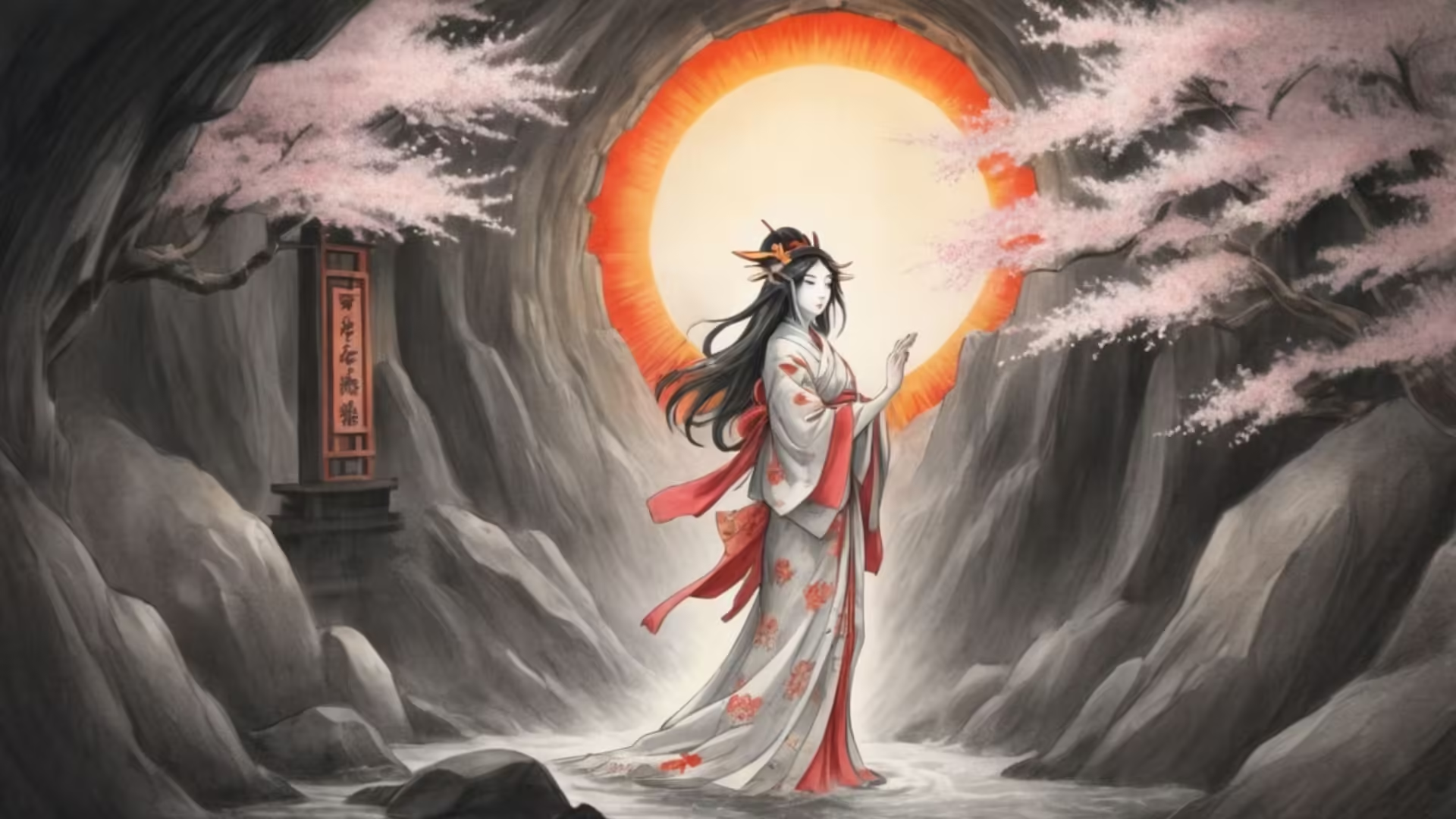The Gist
The Background of Amaterasu
In Japanese mythology, Amaterasu Omikami, often known simply as Amaterasu, is the sun goddess and one of the most revered deities. She is the principal goddess in the Shinto religion, embodying light, warmth, and life itself. Her importance is reflected in the fact that the Japanese imperial family claims descent from her, making her not only a powerful figure in mythology but also a symbolic ancestor in Japanese tradition. Amaterasu’s presence is said to bring life to the world, as her light and warmth nourish all living things.
However, like many figures in myth, Amaterasu has her share of family conflicts. Her younger brother, Susano-o, the storm god, is wild, unpredictable, and often reckless, creating tension between them. Despite their relationship as siblings, Susano-o’s disruptive actions set the stage for one of the most dramatic tales in Japanese mythology.
The Story of Amaterasu Retreating into the Cave
The legend begins when Susano-o, in a fit of rage, disrupts the order of heaven and earth. His antics are relentless—tearing down rice fields, destroying Amaterasu’s sacred weaving loom, and causing chaos wherever he goes. Finally, in a particularly destructive act, Susano-o hurls a skinned horse into Amaterasu’s weaving hall, frightening her and damaging her creations.
Devastated and angered by her brother’s disrespect and violence, Amaterasu retreats into the Amano-Iwato, the Heavenly Rock Cave. Once inside, she seals the entrance, hiding herself away from the world. With the sun goddess hidden, her light is also withdrawn, plunging the entire world into total darkness. Crops fail, the gods grow worried, and humans are left to struggle in the gloom. In this darkness, life comes to a standstill, and despair spreads across the heavens and earth.
The Gods’ Plan to Lure Amaterasu Out
Realizing the danger of a world without the sun, the other gods gather to devise a plan to coax Amaterasu out of her hiding place. The gods hold a great meeting and come up with an idea to bring light back into the world by using humor and curiosity. They decide to stage a grand spectacle outside the cave, hoping that the noise and laughter will capture Amaterasu’s attention and draw her out.
First, the gods place a large mirror near the entrance of the cave, along with a brilliant jeweled necklace, gifts to entice Amaterasu. Then, one of the goddesses, Ame-no-Uzume, begins a lively and outrageous dance. She sings, dances, and even performs a comical striptease that makes all the other gods laugh and cheer. The gods make as much noise as possible, clapping, laughing, and shouting in joy.
Amaterasu, curious about the commotion outside, slowly opens the rock door a crack to peek out. Seeing her own radiant reflection in the mirror, she is momentarily stunned by the beauty and light she brings to the world. While she is distracted, one of the gods, Ame-no-Tajikarao, takes the opportunity to pull the rock door fully open, allowing the light to spill out and restore brightness to the heavens and earth.
The Significance of the Story
The myth of Amaterasu and the Cave is rich with themes that have resonated in Japanese culture for centuries. At its heart, the story speaks to the power of light over darkness, symbolizing the idea that even in the darkest of times, hope and joy can be restored through unity and community. By coming together, the gods are able to overcome the problem and bring light back to the world—a reminder of the strength of collective effort.
This story also emphasizes the importance of harmony and respect within relationships, especially among family. Susano-o’s destructive behavior disrupts the order, but it is the combined effort of the gods, using creativity and humor, that restores balance. The tale reflects the Japanese value of wa, or harmony, an essential principle in both personal relationships and society.
Furthermore, the story explains the origins of certain Japanese rituals. The dance of Ame-no-Uzume is considered the origin of Kagura, a traditional form of dance in Shinto rituals that is still performed in Japan today. This ritual dance is seen as a way of inviting the gods to join in human celebrations, carrying forward the themes of joy and togetherness.
Amaterasu and Japanese Culture Today
Amaterasu remains a central figure in Japan, symbolizing life, renewal, and the unity of the people. The Ise Grand Shrine, one of Japan’s most sacred Shinto sites, is dedicated to Amaterasu, and it is believed that her spirit resides there. The shrine is rebuilt every 20 years in a tradition known as Shikinen Sengu, symbolizing renewal and the passing of generations, much like the themes in the story of the cave.
Amaterasu’s legacy also lives on in Japanese culture and art. Her story is referenced in literature, film, and art, capturing the imagination and continuing to inspire modern retellings. The themes of light and darkness, family unity, and the triumph of joy over despair are as relevant today as they were in ancient times, making Amaterasu’s story one that resonates across ages.
The Lasting Legacy of Amaterasu and the Cave
The tale of Amaterasu and the Cave is more than just a myth—it’s a reminder of the enduring power of light, unity, and the importance of community in overcoming adversity. When faced with darkness, whether literal or metaphorical, the gods use humor, creativity, and teamwork to restore light, a message that carries timeless wisdom. Amaterasu’s story continues to shine in Japanese culture, symbolizing life’s ability to renew itself and the strength we find in coming together. This ancient myth reminds us that, even in the darkest of times, a glimmer of hope and unity can always bring light back to our world.
Let’s Talk
Isn’t the story of Amaterasu and the Cave fascinating? It’s a tale about much more than a goddess hiding away—at its core, it’s about the power of light, resilience, and the strength of community. I love how the gods used laughter and creativity to coax her out of the cave. It makes me think about how, in real life, humor and joy can pull us out of our own “caves” when we’re feeling low or isolated.
Think about it: have you ever found yourself in a situation where you just wanted to shut the door and disappear for a while? Maybe a rough day at work or an argument with someone close left you feeling like hiding out. We’ve all had those moments. And, like Amaterasu, sometimes all it takes is a friend, a family member, or even a fun activity to draw us back out. The gods’ approach in the story is a good reminder that when someone is feeling down, a little light-heartedness and a lot of patience can make all the difference.
And there’s something to be said for the community aspect, too. The gods didn’t leave Amaterasu to stay in the dark forever; they gathered together, worked as a team, and each contributed something to bring her back. Maybe it’s a bit like how we rally around people who are struggling. Have you ever been part of a group effort to cheer someone up? It’s amazing how much energy and kindness people can bring when they come together to support someone.
Another thing that stands out in this myth is the symbolism of the mirror. When Amaterasu peeked out, she saw herself shining in the mirror, almost as if she had to be reminded of her own light. How often do we forget our own strengths when we’re going through a tough time? Maybe what we need is a “mirror”—someone or something to reflect back the things we’re good at or the qualities we bring to others. It’s easy to lose sight of our worth when life gets dark, but sometimes a little reminder can help us see ourselves in a new light.
So, here’s a question: What’s your “mirror” when you’re in a rough patch? Is it a hobby, a friend, or maybe a favorite place that helps you feel like yourself again? And do you think we could all use a bit of that playful spirit the gods showed? Sometimes, maybe the best way to bring someone back to the light is through a little joy, a lot of laughter, and a reminder of just how much they bring to the world.
Let’s Learn Vocabulary in Context
Let’s explore some of the interesting words and phrases from the story of Amaterasu and the Cave. These terms go beyond mythology and can add meaning to our everyday conversations about challenges, relationships, and self-reflection.
First, let’s look at retreat. In the story, Amaterasu retreats into a cave, meaning she withdraws or hides away. We use “retreat” all the time in daily life to describe taking a step back from a situation. You might say, “After a busy week, I like to retreat to a quiet place to recharge,” meaning you need some peace to recover.
Then there’s commotion, which refers to noisy excitement or disturbance. When the gods held a raucous celebration to lure Amaterasu out, they created a big commotion. You might use it to describe anything that’s loud and attention-grabbing, like, “There was a commotion in the office when we found out we were getting a half-day off.”
Radiant means shining brightly, often used to describe light or someone’s appearance. Amaterasu’s light was radiant, illuminating the world when she finally came out of hiding. You could say, “She looked radiant at the party,” meaning she looked bright and happy.
Next, harmony. In the story, harmony among the gods is essential to bringing Amaterasu back. Harmony is a feeling of peacefulness or balance, and it’s something we all look for, especially in relationships. You might say, “Our team works best when there’s harmony and everyone gets along.”
Curiosity drove Amaterasu to peek out of the cave, wondering what the fuss was about. Curiosity is that urge to know or see something. We all know the phrase “curiosity killed the cat,” but it’s often a positive trait. You might say, “Her curiosity led her to explore a new career,” meaning her interest drove her to make a change.
The word mirror has both a literal and symbolic meaning. In the story, the gods used a mirror to show Amaterasu her own light. In life, a mirror can represent anything that reflects back to us, like qualities or emotions. You might say, “Talking to my best friend is like looking in a mirror,” meaning they help you see yourself clearly.
Unity describes people coming together, often for a common cause. The gods’ unity helped them bring light back to the world. You could use it to talk about any group working together, like, “The unity in our neighborhood brought about positive changes.”
The term resilience means the ability to bounce back from difficulties, which Amaterasu shows when she returns to bring light to the world. In our lives, resilience is a valuable trait that helps us face challenges. You might say, “Her resilience helped her overcome obstacles,” meaning she didn’t give up when things got tough.
Symbolism refers to using something (like an object or image) to represent a deeper meaning. The mirror in the story is a symbol of self-reflection. Symbolism is everywhere in art and literature, but we use it in conversations, too. You might say, “The sunrise has a lot of symbolism for new beginnings.”
Finally, lure means to attract or tempt someone. The gods use fun and noise to lure Amaterasu out of the cave. We use it in everyday life when we talk about drawing someone’s interest, like, “The smell of freshly baked bread lured me into the bakery.”
Here are a couple of questions to think about: What’s something that acts as a “mirror” for you, helping you see yourself more clearly? And do you think that creating harmony with others is more important than winning an argument?










0 Comments